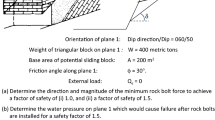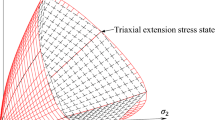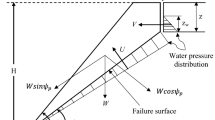Abstract
Characterization of properties governing the stability of rock slopes is essential for their design and analysis. Importance ranking of these properties can be obtained by the sensitivity indices that quantifies the extent to which different properties influence the stability of the slopes. This helps the designers to divert major laboratory/in situ investigation resources to evaluate highly ranked properties. Another usage is to perform the probabilistic stability analysis of slopes efficiently by treating low-ranked properties deterministically in the estimation of probability of failure (\({P}_{\mathrm{f}}\)). In this paper, the importance ranking of rock properties affecting the \({P}_{\mathrm{f}}\) of rock slopes prone to different failure mechanisms is performed using local/global sensitivity approaches (L/GSAs) and the accuracy of these approaches was assessed quantitatively. Four slope case studies indicating different structurally and stress-controlled failures were considered, and sensitivity analyses were performed using six different L/GSAs. Accuracy of the approaches was assessed by comparing the importance ranking of properties based on sensitivity approaches to that of the normalized errors, i.e., \({\varepsilon }_{i}\) invoked in the \({P}_{\mathrm{f}}\) by neglecting the uncertainties in these properties. Results indicated the superior accuracy of GSAs as compared to LSAs. Importance ranking was dependent upon the considered slope (failure mechanisms), with some slopes showing higher sensitivities to external parameters and others to inherent rock properties. An important guideline based on the analysis is suggested to consider the properties as deterministic/random variables in the probabilistic analysis. For the slopes with the minimum interaction effects in their sensitivity (planar, wedge, and stress controlled), uncertainties in multiple properties can be neglected based on the allowable error in the \({P}_{\mathrm{f}}\). Further, a dependence of \({\varepsilon }_{i}\) and corresponding importance ranking was observed on the selected value of property of interest (assumed as deterministic) across its domain in the analysis.













Similar content being viewed by others
Data availability
The datasets in the current study are available from the corresponding author on reasonable request.
Abbreviations
- FOS:
-
Factor of safety
- \({P}_{\mathrm{f}}\) :
-
Probability of failure
- MCS:
-
Monte Carlo simulation
- PEM:
-
Point estimate method
- LSA:
-
Local sensitivity analysis
- GSA:
-
Global sensitivity analysis
- \({\varvec{x}}\) :
-
Vector of input properties \(\{{x}_{1}, {x}_{2}, ..., {x}_{n}\}\)
- \(n\) :
-
Number of input parameters
- \(y\) :
-
Model output of interest
- \(M\) :
-
Model mapping \({\varvec{x}}\to y\)
- \({\mu }_{{x}_{i}}\) :
-
Mean value of \({x}_{i}\)
- \({\sigma }_{{x}_{i}}\) :
-
Standard deviations of \({x}_{i}\)
- \({\varvec{z}}\) :
-
Vector \({\varvec{x}}\) in the standard normal space
- CDF:
-
Cumulative distribution function
- PDF:
-
Probability density function
- \(E()\) :
-
Expectation operator
- \(V()\) :
-
Variance operator
- \(\sim i\) :
-
[Subscript] All the components of the vector except \({i}^{th}\)
- \({F}_{i}\) :
-
CDF of \({x}_{i}\)
- OAT:
-
One at a time
- \(S{I}_{i}\) :
-
Sensitivity index of \({i}^{th}\) input using OAT method
- \(D\) :
-
Variance of \(y\)
- \({S}_{i}\) :
-
First-order Sobol’s indices of \({x}_{i}\)
- \({S}_{{T}_{i}}\) :
-
Total effect Sobol’s indices of \({x}_{i}\)
- HDMR:
-
High-dimensional model representation
- \({\delta }_{i}\) :
-
Borgonovo’s sensitivity measure of \({x}_{i}\)
- \({f}_{{X}_{i}}\left({x}_{i}\right)\) :
-
PDF of \({i}^{th}\) input parameter
- \({f}_{Y}\left(y\right)\) :
-
PDF of output \(y\)
- \({f}_{Y|{X}_{i}}\left(y\right)\) :
-
PDF of output \(y\) conditioned on \({x}_{i}\)
- \({\mathcal{D}}_{{X}_{i}}\),\({\mathcal{D}}_{Y}\) :
-
Entire domain of \({x}_{i}\) and \(y\), respectively
- RSA:
-
Reliability sensitivity analysis
- \({\delta }_{i}^{\mathrm{RSA}}\) :
-
RSA measure of \({x}_{i}\)
- \({\varepsilon }_{i}\left({z}_{0}\right)\) :
-
Error induced in the estimated \({P}_{\mathrm{f}}\) by assuming \({x}_{i}\) property as deterministic at \({z}_{0}\)
- \(\gamma\) :
-
Unit weight of rock mass
- LEM:
-
Limit equilibrium method
- \({k}_{\mathrm{h}}\) and\({k}_{\mathrm{v}}\) :
-
Horizontal and vertical seismic coefficients, respectively
- \(\mathrm{JCS}\) :
-
Joint wall compressive strength
- \(\mathrm{JRC}\) :
-
Joint roughness coefficient
- \({Z}_{\mathrm{w}}\) :
-
Depth of water in tension crack
- \({\phi }_{\mathrm{r}}\) :
-
Residual friction angle of joints
- \({P}_{\mathrm{w}}\) :
-
Water pressure
- RBF:
-
Radial basis function
- ISRM:
-
International Society of Rock Mechanics
- RSM:
-
Response surface method
- LHS:
-
Latin hypercube sampling
- SSR:
-
Shear strength reduction
- GSI:
-
Geological strength index
- UCS:
-
Uniaxial compressive strength
- \({m}_{i}\) :
-
Hoek–Brown constant for intact rock
- \({E}_{i}\) :
-
Young’s modulus of intact rock
References
Aladejare AE, Akeju VO (2020) Design and sensitivity analysis of rock slope using Monte Carlo simulation. Geotech Geol Eng 38:573–585
Alejano LR, Ferrero AM, Ramírez-Oyanguren P, Álvarez Fernández MI (2011) Comparison of limit-equilibrium, numerical and physical models of wall slope stability. Int J Rock Mech Min Sci 48:16–26. https://doi.org/10.1016/j.ijrmms.2010.06.013
Ang AHS, Tang WH (2007) Probability concepts in engineering planning and design: emphasis on application to civil and environmental engineering. Wiley, New York
Antoniano-Villalobos I, Borgonovo E, Lu X (2020) Nonparametric estimation of probabilistic sensitivity measures. Stat Comput 30:447–467
Azarafza M, Akgün H, Ghazifard A, Asghari-Kaljahi E, Rahnamarad J, Derakhshani R (2021) Discontinuous rock slope stability analysis by limit equilibrium approaches–a review. Int Journal of Digital Earth 14(12):1918–1941
Barton N, Choubey V (1977) The shear strength of rock joints in theory and practice. Rock Mech Rock Eng 10:1–54
Borgonovo E (2007) A new uncertainty importance measure. Reliab Eng Syst Saf 92:771–784
Borgonovo E, Plischke E (2016) Sensitivity analysis: a review of recent advances. Eur J Oper Res 248:869–887. https://doi.org/10.1016/j.ejor.2015.06.032
Borgonovo E, Hazen GB, Plischke E (2016) A common rationale for global sensitivity measures and their estimation: a common rationale for global sensitivity measures. Risk Anal 36:1871–1895. https://doi.org/10.1111/risa.12555
Chang Z, Cai Q, Ma L, Han L (2018) Sensitivity analysis of factors affecting time-dependent slope stability under freeze-thaw cycles. Math Probl Eng. https://doi.org/10.1155/2018/7431465
Connor Langford J, Diederichs MS (2013) Reliability based approach to tunnel lining design using a modified point estimate method. Int J Rock Mech Min Sci 60:263–276. https://doi.org/10.1016/j.ijrmms.2012.12.034
Düzgün HŞB, Paşamehmetoğlu AG, Yücemen MS (1995) Plane failure analysis of rock slopes: a reliability approach. Int J Surf Min Reclam Environ 9(1):1–6. https://doi.org/10.1080/09208119508964707
Duzgun HSB, Yucemen MS, Karpuz C (2003) A methodology for reliability-based design of rock slopes. Rock Mech Rock Eng 36:95–120. https://doi.org/10.1007/s00603-002-0034-0
Fu G, Deo R, Ji J, Kodikara J (2021) Failure assessment of reinforced rock slopes subjected to bolt corrosion considering correlated multiple failure modes. Comput Geotech 132:104029
Goodman RE, Bray J W (1976) Toppling of rock slopes. In: proceedings of the specialty conference rock engineering for foundations and slopes, pp 201–234
Hamby DM (1994) A review of techniques for parameter sensitivity analysis of environmental models. Environ Monit Assess 32:135–154. https://doi.org/10.1007/BF00547132
Helton JC, Davis FJ (2003) Latin hypercube sampling and the propagation of uncertainty in analyses of complex systems. Reliab Eng Syst Saf 81(1):23–69. https://doi.org/10.1016/S0951-8320(03)00058-9
Hoek E, Diederichs MS (2006) Empirical estimation of rock mass modulus. Int J Rock Mech Min Sci 43(2):203–215
Hoek E, Carranza-Torres C, Corkum B (2002) Hoek-Brown failure criterion-2002 edition. In: Hammah R, Bawden W, Curran J M T (eds) Mining and tunnelling innovation and opportunity, proceedings of the 5th North American rock mechanics symposium and 17th tunnelling association of Canada conference, pp. 267–273
Iooss B, Lemaître P (2015) A review on global sensitivity analysis methods. In: Meloni C, Dellino G (eds) Uncertainty management in Simulation-Optimization of Complex Systems: Algorithms and Applications. Springer, Berlin
Janon A, Klein T, Lagnoux-Renaudie A, Nodet M, Prieur C (2014) Asymptotic normality and efficiency of two Sobol index estimators. ESAIM Probab Stat 18:342–364. https://doi.org/10.1051/ps/2013040
Jiang SH, Huang J, Zhou CB (2017) Efficient system reliability analysis of rock slopes based on subset simulation. Comput Geotech 82:31–42
Li Z, Hu Z, Zhang X, Du S, Guo Y, Wang J (2019) Reliability analysis of a rock slope based on plastic limit analysis theory with multiple failure modes. Comput Geotech 110:132–147
Low BK, Bathurst RJ (2021) Load-resistance duality and case-specific sensitivity in reliability-based design. Acta Geotech 17:1–19
Luyi L, Zhenzhou L, Jun F, Bintuan W (2012) Moment-independent importance measure of basic variable and its state dependent parameter solution. Struct Saf 38:40–47
Marelli S, Sudret B (2014) UQLab: A framework for uncertainty quantification in Matlab. In: Vulnerability, uncertainty, and risk: quantification, mitigation, and management, pp 2554–2563
MATLAB (2021) Version 9.10 (R2021a). Natick, Massachusetts: The MathWorks Inc
Melchers RE, Beck AT (2018) Structural reliability analysis and prediction. Wiley, New York
Morris MD (1991) Factorial sampling plans for preliminary computational experiments. Technometrics 33:161–174. https://doi.org/10.1080/00401706.1991.10484804
Nowak AS, Carr RI (1985) Sensitivity analysis for structural errors. J Struct Eng 111:1734–1746. https://doi.org/10.1061/(ASCE)0733-9445(1985)111:8(1734)
Pandit B, Babu GLS (2018) Reliability-based robust design for reinforcement of jointed rock slope. Georisk Assess Manag Risk Eng Syst Geohazards 12(2):152–168. https://doi.org/10.1080/17499518.2017.1407800
Pandit B, Babu GLS (2022) Global sensitivity analysis for a tunnel-support system in weak rock mass for both—uncorrelated and correlated input parameters. Rock Mech Rock Eng 55:1–18
Pandit B, Tiwari G, Latha GM, Babu GLS (2018) Stability analysis of a large gold mine open-pit slope using advanced probabilistic method. Rock Mech Rock Eng 51(7):2153–2174
Pandit B, Tiwari G, Latha GM, Babu GLS (2019) Probabilistic characterization of rock mass from limited laboratory tests and field data: associated reliability analysis and its interpretation. Rock Mech Rock Eng 52(9):2985–3001. https://doi.org/10.1007/s00603-019-01780-1
Pan Q, Dias D (2017) Probabilistic evaluation of tunnel face stability in spatially random soils using sparse polynomial chaos expansion with global sensitivity analysis. Acta Geotech 12(6):1415–1429
Park H, West TR (2001) Development of a probabilistic approach for rock wedge failure. Eng Geol 59(3–4):233–251
Phoon KK, Ching J (2018) Risk and reliability in geotechnical engineering. CRC Press, London
Raghuvanshi TK (2019) Governing factors influence on rock slope stability – Statistical analysis for plane mode of failure. J King Saud Univ Sci 31(4):1254–1263. https://doi.org/10.1016/j.jksus.2019.01.002
Rocscience Inc. 2008. PHASE2 version 9.0–finite element analysis for excavations and slopes. Rocscience Inc., Ontario
Roy D, Maheshwari P (2018) Probabilistic analysis of rock slopes against block toppling failure. Indian Geotech J 48(3):484–497. https://doi.org/10.1007/s40098-017-0281-3
Saltelli A (2002) Making best use of model evaluations to compute sensitivity indices. Comput Phys Commun 145(2):280–297. https://doi.org/10.1016/S0010-4655(02)00280-1
Saltelli A, Annoni P (2010) How to avoid a perfunctory sensitivity analysis. Environ Model Softw 25:1508–1517. https://doi.org/10.1016/j.envsoft.2010.04.012
Saltelli A, Tarantola S, Campolongo F, Ratto M (2004) Sensitivity analysis in practice: a guide to assessing scientific models. Wiley Online Library, New York
Saltelli A, Ratto M, Andres T, Campolongo F, Cariboni J, Gatelli D, Saisana M, Tarantola S (2008) Global sensitivity analysis: the primer. John Wiley & Sons, New York
Saltelli A, Annoni P, Azzini I, Campolongo F, Ratto M, Tarantola S (2010) Variance based sensitivity analysis of model output. Design and estimator for the total sensitivity index. Comput Phys Commun 181(2):259–270. https://doi.org/10.1016/j.cpc.2009.09.018
Saltelli A, Aleksankina K, Becker W, Becker W, Fennell P, Ferretti F, Holst N, Li S, Wu Q (2019) Why so many published sensitivity analyses are false: a systematic review of sensitivity analysis practices. Environ Model Softw 114:29–39. https://doi.org/10.1016/j.envsoft.2019.01.012
Schmid F (2018) A new moment-independent measure for reliability-sensitivity analysis. ETH Zurich Master Thesis
Schmid F, Marelli S, Sudret B (2019) A new moment-independent measure for reliability-sensitivity analysis. In: 3rd International Conference on Uncertainty Quantification in Computational Sciences and Engineering (UNCECOMP 2019). ETH Zurich, Chair of Risk, Safety and Uncertainty Quantification
Sobol IM (1993) Sensitivity analysis for non-linear mathematical models. Math Modell Comput Exp 1:407–414
Sohier H, Piet-Lahanier H, Farges JL (2015) Analysis and optimization of an air-launch-to-orbit separation. Acta Astronaut 108:18–29. https://doi.org/10.1016/j.actaastro.2014.11.043
Tatone BSA, Grasselli G (2010) ROCKTOPPLE: a spreadsheet-based program for probabilistic block-toppling analysis. Comput Geosci 36(1):98–114. https://doi.org/10.1016/j.cageo.2009.04.014
Tiwari G, Latha GM (2019) Reliability analysis of jointed rock slope considering uncertainty in peak and residual strength parameters. Bull Eng Geol Environ 78(2):913–930
Tiwari G, Latha GM (2020) Stability analysis and design of stabilization measures for Chenab railway bridge rock slopes. Bull Eng Geol Environ 79(2):603–627. https://doi.org/10.1007/s10064-019-01602-2
Tiwari G, Pandit B, Latha GM, Babu GLS (2017) Probabilistic analysis of tunnels considering uncertainty in peak and post-peak strength parameters. Tunn Undergr Space Technol 70:375–387
Wyllie DC, Mah CW (2004) Rock slope engineering: civil applications, 4th edn. CRC Press, London
Zheng H, Liu DF, Li CG (2005) Slope stability analysis based on elasto-plastic finite element method. Int J Numer Meth Eng 64(14):1871–1888
Author information
Authors and Affiliations
Corresponding author
Additional information
Publisher's Note
Springer Nature remains neutral with regard to jurisdictional claims in published maps and institutional affiliations.
Appendix
Appendix
1.1 Importance sampling
Importance sampling method is used to obtain a better estimate of \({P}_{f}\) of the system by sampling from a different distribution other than \({f}_{{\varvec{X}}}({\varvec{x}})\) that ensures preferred sampling from the failure region of the output domain leading to faster convergence and reduction in computational costs. The different distribution is known as importance sampling function \(\psi ({\varvec{x}})\).
where {\({{\varvec{x}}}^{(1)}, {{\varvec{x}}}^{(2)},\dots ,{{\varvec{x}}}^{(N)}\)} is drawn from \(\psi ({\varvec{x}})\).
In this article, first a FORM analysis is conducted in the standard normal space (\({\varvec{U}}\)) for the rock slopes and design point \({{\varvec{U}}}^{*}\) is obtained. Then, to obtain an efficient importance sampling function, mean of \(n\)-dimensional standard normal distribution (\({\phi }_{n}({\varvec{u}})\)) is shifted to \({{\varvec{U}}}^{*}\) as suggested by Melchers [29]. Thus,
Sampling from \(\psi \left({\varvec{u}}\right)\) will ensure greater sampling density in the failure region. Additionally, approximately 50% of these samples fall under the failure region of the system [29].
Rights and permissions
Springer Nature or its licensor (e.g. a society or other partner) holds exclusive rights to this article under a publishing agreement with the author(s) or other rightsholder(s); author self-archiving of the accepted manuscript version of this article is solely governed by the terms of such publishing agreement and applicable law.
About this article
Cite this article
Pandit, B., Kumar, A. & Tiwari, G. Assessing the applicability of local and global sensitivity approaches and their practical utility for probabilistic analysis of rock slope stability problems: comparisons and implications. Acta Geotech. 18, 2615–2637 (2023). https://doi.org/10.1007/s11440-022-01739-7
Received:
Accepted:
Published:
Issue Date:
DOI: https://doi.org/10.1007/s11440-022-01739-7




